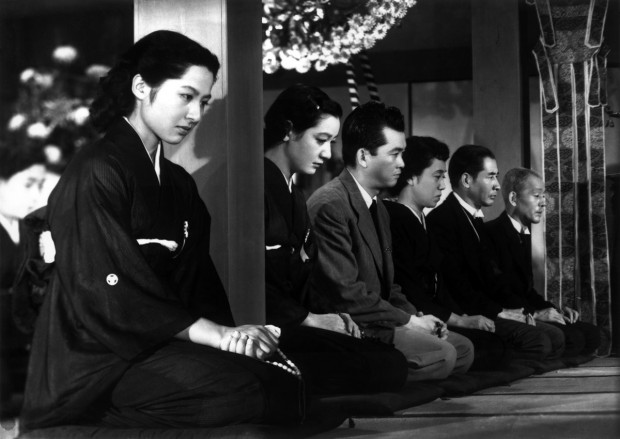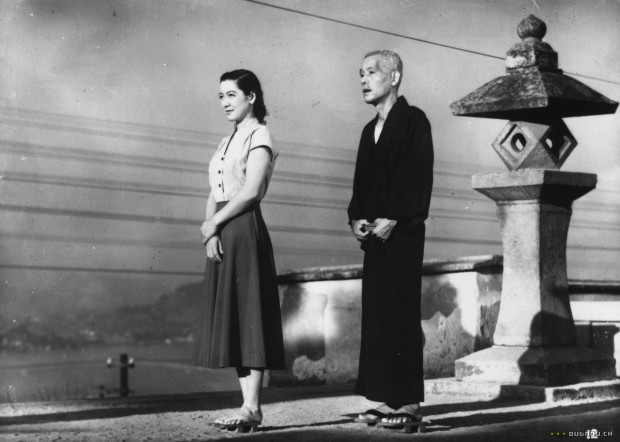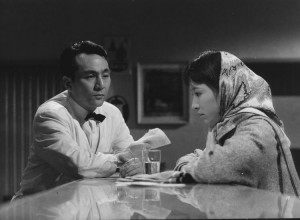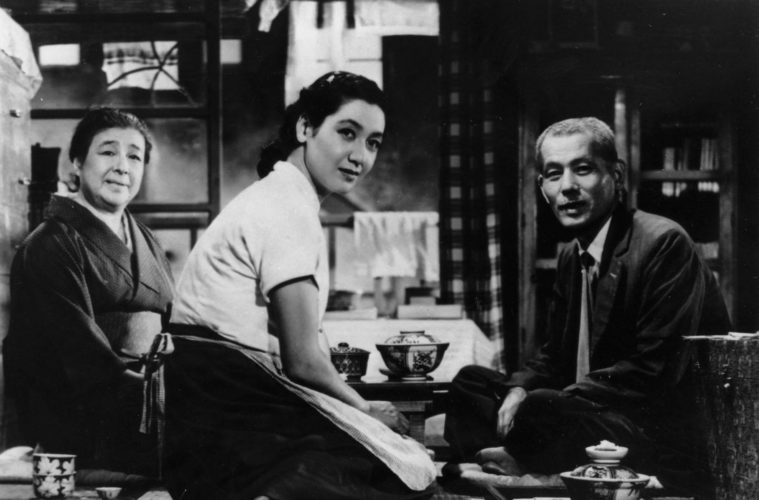When the Criterion Collection announced that Yasujirô Ozu’s towering 1953 work, Tokyo Story, would be coming to Blu-ray, my first reaction was “shit.” Not that this canonical work — beloved by cinephiles, filmmakers, academics, and nearly all else who encounter it — is undeserving of further attention. Instead my own reaction to this film, which I’ve viewed four times over the last decade, remains a constant struggle. Ozu’s most-cited picture — a timeless examination of the tragedy inherent to generational divides — is the work of a director who displays mastery in the fields of cinematic and narrative construction. Yet I’ve always felt baffled by my own lack of an emotional engagement, never able to pinpoint what it was that bred such frustration. Like those tapestries that lay behind Ozu’s credits, I’m in awe of the work’s “perfection” (no thread left hanging), but something in both the philosophy of Ozu and Tokyo Story’s particular angling toward those themes has always left me suspicious.
This, mind you, is not another “young philistine with little wit thinks he’s too cool for the canon” piece. My ambivalence toward Ozu does not come lightly, and I always assumed that my teenage self who found Tokyo Story (as well as Late Spring) “boring” was simply not attuned to the richness of his cinematic flavor. Thus, during a retrospective at New York City’s Film Forum this past summer, I took in 20 of his 35 extant films (all on 35mm!) over the course of a month, hoping to teach myself the Japanese master’s style. This method of inundation had worked in cracking Robert Bresson just one year prior — in that case, I was finally hooked after five titles — so, surely, a similar result could be expected of Ozu: the complexity of his constructive editing might rival Bresson, but the actual narratives are certainly less didactic.
This isn’t to suggest that Ozu’s canonization needs any questioning, nor that anyone (including myself) is doubting his significance within the scope of cinematic history. This was, after all, a director who won the heart of America’s most popular critic (Roger Ebert) and its most formalist academic (David Bordwell), all while still beloved in his homeland. Tokyo Story itself topped the Sight & Sound list of the greatest films of all time, as voted on by fellow directors — a body that includes diverse names such as Asghar Farhadi, Béla Tarr, and Steve McQueen.
I’ve always taken what follows to be my Ozu problem, and to directly put into words why I’ve never fully accepted the director has been a great fear. Of the canonical filmmakers, is there anyone out there with fewer detractors? Ford is too sentimental; Kubrick is too cold; Hitchcock is too controlling; Godard is too didactic; and Antonioni is too abstract. Whether or not you believe these arguments, they certainly do exist. But what about Ozu? Although there are some cases of dissent — Noël Burch, for instance, prefers the early ‘30s work to his late period (“Late Ozu” usually refers to any work after 1949’s Late Spring) — one, today, would be hard-pressed to find a strong collective of dissenters, or even an easy turn of phrase to use. In his 1972 top ten list, compiled for The Village Voice, Andrew Sarris lamented, “Yasujiro Ozu’s ‘Late Spring’ and ‘The Tokyo Story’ stay in my mind for their extraordinary virtuosity and control, but something that I cannot articulate adequately still bothers me about Ozu.” Sarris largely avoided writing about the director over his years (despite mentioning An Autumn Afternoon on his 1973 top ten), perhaps unable to reach some genuine articulation on him.
So how did Ozu get to the top? This was a director who went largely ignored in the West throughout his active career, quietly making films while the pages of Cahiers du cinéma marked party lines between Kurosawa and Mizoguchi. His films eventually seeped through European and American festivals: Tokyo Story had a 1956 screening at the Los Angeles Film Festival and a 1957 screening in London, while acclaimed Japanese cinema scholar Donald Richie championed his name through the pages of Film Quarterly. Ozu finally reached mainstream audiences in 1972, almost a decade after his death, with the publication of Paul Schrader’s Transcendental Style in Film: Ozu, Bresson, Dreyer, as well as the commercial release of Late Spring and Tokyo Story. Following serious inquiries by David Bordwell, Kristin Thompson, Richie, and Burch, Ozu slowly developed a reputation — this budding profile no doubt assisted by complete career retrospectives in London (1975) and New York (1982). Tokyo Story reached the Sight & Sound list in 1992, debuting at #3, and is now a mainstay.
Besides the general formalist properties, one can also see another essential reason to embrace Ozu’s cinema — he fills an all-important “non-Western” role in the canon, best emphasized by that always-cited claim of being “the most Japanese” of the country’s directors. This might pose the question of who’d be the most American of American directors; even if one begins to subscribe such ideals to Hawks or Ford, it comes across as a limiting declaration that ignores their actual filmmaking. What credence entails being exemplary of one’s own culture? Besides, one might forget that Ozu grew up watching Ford movies (the Stagecoach theme is hummed in Tokyo Story), or that he often cited artists such as Harold Lloyd and Ernst Lubitsch in his career, or that Tokyo Story was modeled off of Leo McCarey’s Make Way for Tomorrow. (While this picture was unseen by the director, it was well-known by his co-writer, Kôgo Noda.)

Needless to say, the canonization of Tokyo Story over the rest of Ozu’s oeuvre may have less to do with any of its cultural relevance and, rather, pertain more to the film’s accessibility — not only in terms of its initial arrival on American shores, but the sheer universality of a narrative wherein an aging patriarch and matriarch visit their children in Tokyo, only to find themselves somewhat callously moved around, a nuisance to those occupied by busy work schedules. (Only the widow of their second son displays any humility and respect.) After returning to their (evidently pre-war) village of Onomichi, the mother passes away from illness after the children have gathered.
To speak in favor of Ozu, let it be noted that his picture, often (naïvely) described as “plotless,” is far from it, and how spectators are forced to grasp the narrative at hand is hardly simplistic. Through the long second sequence at the home of Koichi, Ozu teases out various relationships in this family: the unseen son, Keizo, who lives in Osaka; the carefully acknowledged disappointment of Koichi’s position; or the fact that Noriko is not a daughter, but a widow. None of these crucial expositional points are directly stated, but, rather, drawn out through the ritual conversations. In his invaluable book Ozu and the Poetics of Cinema, Bordwell notes that Ozu constantly forces the spectator to re-evaluate Tokyo Story‘s relationships via the careful hints placed within dialogue — even during the penultimate scene, Shukichi tells his neighbor, that he could have treated his wife more kindly while she was alive; we, the audience, have not had a sense of this before — a moment which demonstrates Ozu’s “discreet manipulation of fabula data.”
But I also find there to be a certain callousness to the archetypes Ozu employs, where perhaps some of his ellipses and sudden shifts betray the characters in order to reach philosophical goals. The grandparents’ stay at Koichi’s takes place over a few days, but we only see two of them, the notable event of a young boy’s sudden illness delaying their first tourist trip through Tokyo. We don’t return to Koichi until the scene where he and Shige decide to send their parents to the vacation spot in Amati — and if he’s ambivalent about his relationship to his parents, it isn’t present in Ozu’s narrative; his failures as a son and a doctor are enumerated, but the lack of his own point-of-view within the narrative feels a bit too calculated.
More notable and most frustrating is Noriko, played by “Eternal Virgin” of Japan, Setsuko Hara. Suffering from immense guilt over the death of her husband during the war, she shows an inordinate amount of dedication to her in-laws. Noriko is practically an angelic character, and Ozu ensures we are witness to every sacrifice in some form of comparison with the parents’ generally selfish children. Ozu puts her into contrast with Shige, who is callous to a fault — she never gets a single moment of repose. That Noriko becomes the film’s moral center and delivers the film’s ideals would strike me less as a virtue of “the most beautiful character in cinema history” and more a virtue where even her self-deprecating feelings about eventual, personal change resonate as so calculated that I struggle placing her within this family network. The film’s most famous exchange — “Isn’t life disappointing?” “Yes, it is.” — might begin with a bold revelation, but this double and triple underlining of themes feels terribly on-the-nose.
Ozu claimed Tokyo Story was “the most melodramatic” of his films; while other entries might better compete for that title, its third act struck me as too perfectly balanced for both pathos and disappointment, to the end that even Keizo’s sudden decision to rush back to Osaka with an intent of watching baseball feels like the strings of Ozu’s narrative cloying toward our own bitter resentment. Ozu’s philosophy — the Zen Buddhist ideology identified by Schrader — is a certainly unique presence in the landscape of world cinema. Yet, in Tokyo Story, I feel as if Ozu had stacked the deck to enforce this philosophy that feels like a little too much — where the simple sense of disappointment comes with neither much moral weight nor, even, characters actually grasping and struggling with their decisions. Instead, there’s the sense of watching pawns move across a chessboard, a reaction especially notable when the filmmaking and acting feel so grounded.
Similarly, Ozu’s visual style in Tokyo Story is the most succinct of his form: the deliberately broken eye-line shots that shatter classical 180-degree editing, the seemingly simple use of “pillow shots” that act as poetic transitions, and the general stillness of his cinema. Often, Ozu finds images that left me devastated: an early pillow shot of boys biking along a hill is later repeated as a set-up for the lovely scene between the grandmother and her grandson; the straight-on shot of Noriko briefly looking down when hinting at the guilt over her husband (as much as I feel conflicted about the character, Hara certainly creates an entire inner life); a long shot of the grandmother struggling to get up on the beach while her husband begins to walk away; and the children sitting around their now-dead mother, each character placed perfectly in the frame.
 In general, though, I can’t help but feel that the style is imposed, and that these so-called “poetics” Bordwell and Richie find – what breathes life into Ozu — are almost oppressive. What, exactly, does Ozu gain by creating these non-traditional eye-line conversations? In the 5th edition of Film Art, Bordwell and Thompson explain that Ozu allows the “stylistic devices to exist independently alongside narrative,” thus allowing that the spectator may “participate in a play space and time.” The film’s subtle gestures — a constant waving of fans, the head nods given when characters speak to each other, and those pillow shots of boats and trains, themselves a reminder of both serenity and the aging world — begin to feel less like a necessity and more a rigidity of an auteurist sensibility.
In general, though, I can’t help but feel that the style is imposed, and that these so-called “poetics” Bordwell and Richie find – what breathes life into Ozu — are almost oppressive. What, exactly, does Ozu gain by creating these non-traditional eye-line conversations? In the 5th edition of Film Art, Bordwell and Thompson explain that Ozu allows the “stylistic devices to exist independently alongside narrative,” thus allowing that the spectator may “participate in a play space and time.” The film’s subtle gestures — a constant waving of fans, the head nods given when characters speak to each other, and those pillow shots of boats and trains, themselves a reminder of both serenity and the aging world — begin to feel less like a necessity and more a rigidity of an auteurist sensibility.
In an essay composed for Masters of Cinema’s release of Floating Weeds, Ignatiy Vishnevetsky remarks that Ozu’s post-war filmography is “remarkably self-contained as it is radical […] His mature work breaks all traditional rules of continuity. It has its own aesthetic of visual composition.” At some point, these rules of Ozu’s filmmaking begin to feel less at ease within Tokyo Story, instead coming across as a didactic statement, as if one were to suddenly notice all the strings during a performance of puppets. Although Ozu’s filmmaking may reflect certain sensibilities of Japanese philosophy or find poetic transcendence (which Tokyo Story certainly does at moments), I can’t help but notice the puppet master behind it all, suddenly disconnected from the drama unfolding. In Tokyo Ga, Wim Wenders’s interviews with Ozu’s cameramen and performers note that the master even kept a stopwatch, as if the shot’s duration needed to be pinpointed to a science. These no-room-for-error approaches might make sense in Hitchcock’s rat-maze puzzles, but Ozu’s stories are meant to concern the natural shifts in life, as his seasonal titles (Early Summer, An Autumn Afternoon, etc) would suggest.
However, as my investigation into the entirety of Ozu’s career would reveal, the output consisting solely of Late Spring and Tokyo Story was not necessarily reflective of an entire career, and the way Kent Jones writes of the difference between Ingmar Bergman and “Bergman” could be applied here. A typified image of Ozu certainly exists when viewing the late works: family dramas, issues of marriage, characters speaking straight to the camera, and the use of the “pillow shot” to establish a rhythm perhaps along the lines of “life goes on.” (Many of these are quite exciting, I should note — the final shots of barley in Early Summer are perhaps the most transcendent example.) Yet to do so would be to ignore the Ozu who made a cornucopia of films. There are comedies — not just the antics of the now-canonical I Was Born But…, but college stories like I Flunked, But… — a gangster tale (or possible parody) in Dragnet Girl, the neo-realist narratives of poverty in An Inn in Tokyo and The Only Son, as well as a sort of reverse take on The Kid with a Bike in the comedic Record of a Tenement Gentleman.
While I would not say I have a strong preference toward the 1930s work like Burch, I’m nevertheless struck at how much dynamic fluidity some of these films will offer in comparison to late-era Ozu. A title such as The Only Son, his first sound work, is a messier, more fascinating counterpoint to Tokyo Story — it concerns a small-village mother who visits her son in the capital. But the emotional territory is riskier. The son, though dutiful and honorable, has little-to-no success, all of which is foregrounded by a prologue in which the mother concedes her middle-class life for his education. Slowly, the film mines this narrative in a way that poses their diametric relationship toward a necessary conclusion of acceptance, instead of one that feels like a sideline. The Only Son, hardened by its neo-realist depiction of Tokyo, asks us to contemplate the value of what may constitute a good life in the absence of success.
Again, this is not to say that early Ozu is “more interesting” than Late Ozu, but that, once one turns away from a hermetically sealed style, his aberrations become more fascinating than his defining traits. A rare film with Toho Studios, The Munekata Sisters, is mostly disdained by his champions for both abandoning the realist sets and working with a more heavy-handed script, but the performance by Naruse regular Hideko Takamine is a revelation within these constricted worlds, providing a loose energy (as well as songs!) to this setting, and the film’s prolonged rain sequence near the climax ranks with the most poetic moments of his career.
If anything, what I become most attuned to is Ozu’s moving camera; seen in opposition to his stagnant, 180-degree rule-breaking shots, the motions become breathtaking. The concluding shot of his silent, Mizoguchi-like melodrama, Woman of Tokyo, creates a certain sense of afterlife continuing beyond the narrative itself. In Early Summer, a penultimate, beach-set sequence features what is surely the director’s most loving gesture: as two women walk along a beach, the camera rises above the ground level with sweeping grandiosity. The dolly shots appear throughout the silents and early sound works with an openness to explore the world instead of impose on it. (Two all-too-brief camera movements even appear in Tokyo Story.) While even more obvious than any of Ozu’s other rigorous techniques, these touches reveal someone who does not ingrain drama into his filmmaking, but lets the filmmaking breathe out of his drama.
 Perhaps, then, the finest choice for canonization might be Tokyo Twilight. Ozu’s longest and darkest film, it’s a 1957 masterpiece often lost in conversation centered on the first string of late Ozu works and the interest gleaned from his color films. The story of two sisters, their father, and an absent mother, Tokyo Twilight features some of Ozu’s most melodramatic narratives — divorce, adultery, abortion, and more — but I also feel that the picture offers something unique: a truly balanced relationship between its four major oppositional characters. Their moral choices are never as clear as they are complex, showing signs of both selfishness and selflessness — often within the same gestures. Set in the dead of winter and filled with nontraditional locations — a seedy mahjong parlor and a French bar that could’ve been in a film noir — Ozu hits more didactic tones while indulging in more oblique tragedy, most notably during an elongated train sequence that draws out utter disappointment. There is a certain sting that offers more than just the usual whims of Ozu, as well as a stronger expression of lighting that offers some of his most dynamically composed frames. While a major disappointment to Japanese critics when originally released, I feel its ambitions were unfairly mistreated, and that Ozu’s color period would have certainly been more interesting if he hadn’t retreated into a previously established base.
Perhaps, then, the finest choice for canonization might be Tokyo Twilight. Ozu’s longest and darkest film, it’s a 1957 masterpiece often lost in conversation centered on the first string of late Ozu works and the interest gleaned from his color films. The story of two sisters, their father, and an absent mother, Tokyo Twilight features some of Ozu’s most melodramatic narratives — divorce, adultery, abortion, and more — but I also feel that the picture offers something unique: a truly balanced relationship between its four major oppositional characters. Their moral choices are never as clear as they are complex, showing signs of both selfishness and selflessness — often within the same gestures. Set in the dead of winter and filled with nontraditional locations — a seedy mahjong parlor and a French bar that could’ve been in a film noir — Ozu hits more didactic tones while indulging in more oblique tragedy, most notably during an elongated train sequence that draws out utter disappointment. There is a certain sting that offers more than just the usual whims of Ozu, as well as a stronger expression of lighting that offers some of his most dynamically composed frames. While a major disappointment to Japanese critics when originally released, I feel its ambitions were unfairly mistreated, and that Ozu’s color period would have certainly been more interesting if he hadn’t retreated into a previously established base.
Yet Tokyo Twilight sits nowhere near most lists of great Ozu while Tokyo Story remains firmly grounded near the top, the film that most resembles “Ozu” while not necessarily Ozu himself. Tokyo Story remains an essential film in cinephile culture: it’s not only an easy introduction into a slower and quieter form of narrative, but also establishes precedents for the narrative and visual proclivities of a murderer’s row of essential world-cinema artists (many being celebrated in an upcoming retrospective revolving around the theme). Tokyo Story provides the setting for one of cinema’s great tragedies and a pragmatism toward life’s disappointments, all presented in a form that, for its sheer complexity, few other cinematic artists would ever attempt to ape. If nothing else, one hopes that cinephiles and regular movie-goers alike who, via Criterion’s Blu-ray, fall in love with Tokyo Story only make it the beginning of their journey through Ozu, and for at least two things to follow: they question what ranks this picture as more essential than the others, and ask what they actually take away from his work.
One caveat to leave this essay with: one of my favorite Bordwell pieces is a 1975 response to his own study of Citizen Kane, written in 1971 at the tender age of 20. Bordwell goes on to critique his own assessment, perhaps harder on himself than any editor would have been, calling it “a very youthful effort.” Likewise, as I write these words, I feel that this essay will haunt me in my wake — years from now, I’ll finally be freed from my blindness and recognize Ozu as seemingly all my contemporaries have, only feeling foolish for having even considered questioning the accepted readings of his work. Honestly, I would prefer that to remaining ambivalent.
But Ozu remains my white whale, that director I feel duty-bound to chase through a cinephile life as I come to terms with his oeuvre. Perhaps Sarris never wrote at length on the man because he knew he’d never feel completely at peace in articulating an ambivalence, as I certainly feel now. Furthermore, I fear Ozu’s own reaction to my trepidation would be something of a saddened but shrugging gesture toward life’s greater impossibilities, and I fear that I’ll never find peace in learning how and why this director strikes such discordant chords in me. Isn’t life disappointing?
Toyko Story is now available on The Criterion Collection.


